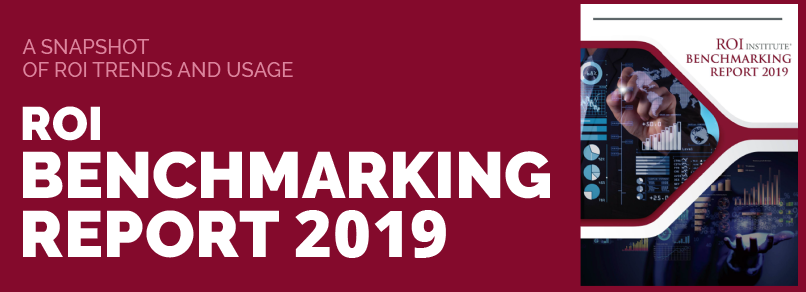Seven Key Takeaways from the 2019 Benchmarking Study
Every few years, ROI Institute® conducts a benchmarking study to identify trends of use for the ROI Methodology®. These trends provide other practitioners with the opportunity to compare their usage of the ROI Methodology® to what others are doing. The results for our study, conducted in late 2019, are out now.
Get the complete 2019 Benchmarking Report here
Below are our seven key takeaways:
- Increase in early planning for evaluation of programs We have always advocated for developing evaluation plans when the program is designed or during program conception. Our survey respondents mentioned that this is done 58% of the time, which is a significant improvement over the last few years.
- Programs are being evaluated up to Impact and ROI at a much higher rate While we recommend evaluating 10-20% of the programs up to Level 4 - Impact, respondents indicated they evaluate about 37% of the programs at this level. Similarly, we suggest evaluating 5-10% of your programs at Level 5 - ROI, but 18% of programs are being evaluated at this level right now. This shows practitioners are taking an aggressive approach to evaluation and pushing their evaluations to the highest levels.
- Surveys and questionnaires are still the most frequently used methods for data collection Respondents indicated they use surveys and questionnaires about 71% percent of the time when collecting data. While these methods can be helpful, we encourage ROI Methodology users to also obtain and utilize data that already exist, such as performance records or organizational databases, and use alternatives to surveys, such as action plans and performance contracts.
- More credible methods are being used to isolate the effects of programs According to our users, 34% of studies utilize experimental vs. control group, and 40% use classic trendline analysis. Additionally, some type of mathematical modeling is used 28% of the time. When these methods work, they are highly credible. Estimates are used as a fallback with participant estimates being the primary fallback. We recommend that estimates be collected during every study, but only analyzed and included as an isolation method when more credible methods cannot be used.
- Converting data to money is getting easier Respondents reported that they utilize standard values accepted within their organization 52% of the time. These values are available, published, and accepted by executives. Survey participants also indicated they use internal or external experts to provide data 45% of the time.
- Senior executives are still driving the requirement for ROI in most organizations C-suite executives know that ROI is the ultimate evaluation, and they are pushing their organizations to integrate an ROI approach into their processes, programs, projects, and initiatives. We recommend that practitioners be proactive and not wait for their senior executives to push for the ROI.
- The main enabler to successful ROI implementation is support from management You always want to have management on your side as they can make or break the success of ROI implementation. It is not difficult to secure management support for this level of analysis. It is generally seen as a welcome action.
This benchmarking data shows overarching trends of what others are doing, but you are the key to establishing ROI trends in your own organization. Learning more about the ROI Methodology® will enable you to evaluate your programs up to ROI, collect relevant data to facilitate that evaluation, isolate what causes the improvement in your key measures, build evaluation into your program creation process, and get your managers on board. Be proactive and start this process before your executives tell you to.








